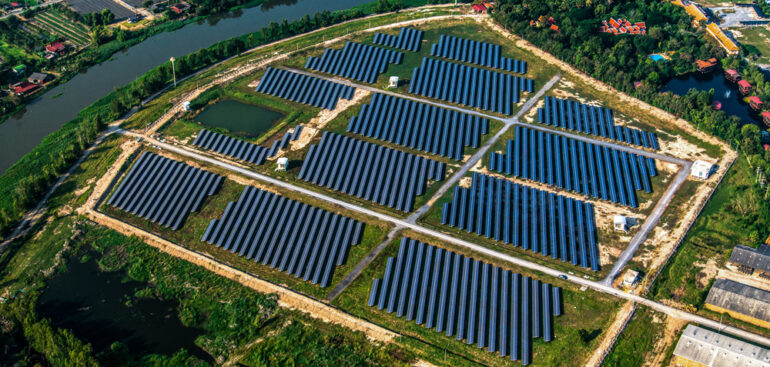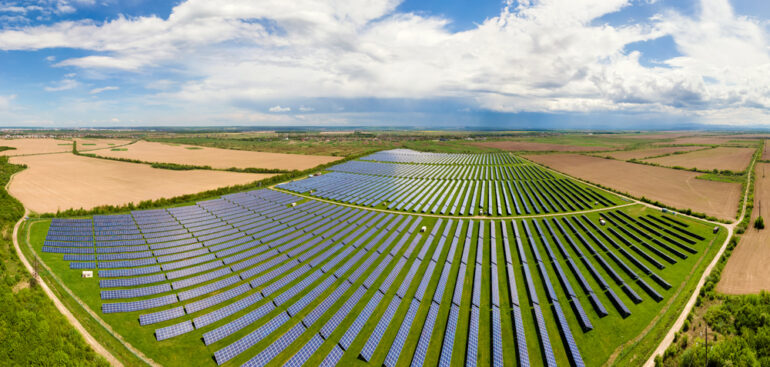India added 2.5 GW of solar open access in the calendar year (CY) 2022, a year-over-year (YoY) increase of 92% from the 1.3 GW installed in CY 2021, according to the newly released 2022 Q4 & Annual Mercom India Solar Open Access Market Report.
The year marked the highest-ever annual installations of solar open access, driven by developers’ need to avoid a 40% Basic Customs Duty on solar modules. The higher tax rates became effective from April 1 last year.
Further, the commissioning of open access projects accelerated owing to a lack of clarity about the applicability of the Approved List of Models and Manufacturers regulations. However, the government clarified in October that projects which had applied for approval before October 1 last year would be exempt from ALMM.
Additionally, the commissioning of projects delayed in 2021 due to the COVID-19 pandemic also contributed to the doubling of installed capacity in 2022 YoY.
However, the breakneck project commissioning speed slowed down drastically in the fourth quarter (Q4) of CY 2022 as India added just 293 MW of solar open access capacity, a decline of 52% quarter-over-quarter and 10% YoY.
Karnataka added the most solar open access capacity in CY 2022, followed by Maharashtra, Tamil Nadu, Chhatisgarh, and Uttar Pradesh. The top five states accounted for 77% of the total installations during the year.
The cumulative installed solar open access capacity stood at 7.7 GW as of December 2022.
Karnataka remained the leading state, accounting for over 32% of the capacity addition in the quarter. The top five states contributed over 96% of all open access installations during the quarter.
The development pipeline of solar open access projects in the country totaled 6.6 GW as of Q4 2022. Nearly 70% of this pipeline is in Andhra Pradesh, Rajasthan, Karnataka, Maharashtra, and Gujarat.
Cumulatively, Karnataka was the leading state in solar open access installations, accounting for nearly 36% of the total capacity, followed by Maharashtra, with over 12% of the total installations.
The captive and group captive models have seen a rise in demand in the country, given the surcharge exemptions and lower net landed costs.
The third-party installations, however, saw a considerable impact due to the substantial cross-subsidy and additional surcharges in states like Karnataka, Telangana, and Maharashtra.
In Telangana, Haryana, Gujarat, and Uttarakhand, the additional surcharges were altered during the last quarter leading to revised net landed costs.
Chhattisgarh continued to have the lowest net landed cost among all states, followed by Andhra Pradesh and Odisha.
“The solar installations in the open access segment overcame the regulatory challenges and recorded the best year to date despite the odds. The overwhelming growth reflects the demand by industrial and commercial units keen on sourcing clean power and conscious of the economic benefits. Though the government has announced that consumers with sanctioned load of 100 kW and above are eligible to source green power through open access, consumers below 1 MW demand remain largely underserved and are a dormant market,” commented Priya Sanjay, Managing Director at Mercom India.
Short-term Market
Andhra Pradesh was the largest electricity supplier in the Green Day-Ahead Market (G-DAM), accounting for over 40% of the market share in Q3 CY 2022.
Gujarat emerged as the leading procurer of energy from the G-DAM, followed by Maharashtra, which accounted for 14.6% and 12.5% of the total power purchased during Q3 CY 2022.
The Delhi High Court’s suspension of trading in renewable energy certificates issued before October 31, 2022, for six weeks adversely impacted energy trading in the fourth quarter.
Mercom expects 2023 to be a stronger year for solar open access installations, given the significant pipeline, removal of the ALMM mandate, and lower power purchase agreement tariffs.
The increased awareness of the cost-saving benefits offered by open access, particularly under captive and group captive business models, among C&I consumers, is expected to encourage the rapid adoption of open access in 2023.
The report further provides an in-depth analysis of the solar open access segment in seventeen states, including a comprehensive coverage of open access charges, retail supply tariffs, and the market size of each state.
The report includes insights on the average power purchase agreement prices, net landed costs, banking regulations, short-term transactions, and open access policies and regulations that were introduced in Q4 2022.
The report sheds light on the perspectives and opinions of leading open access installers nationwide during the quarter.
Despite the record-high investments, it is crucial to note that annual investments must increase over four-fold to stay on course toward the 1.5°C scenario, the agency said in a report.
The world must aim for average annual investments of $5.7 trillion between 2021 and 2030 and $3.7 trillion between 2031 and 2050 to successfully transition to sustainable energy sources, the report said.
Despite facing various economic, social, and geopolitical obstacles, the world’s investments in renewable energy generation have maintained an upward trajectory that started in 2018.
The latest data indicates that investments in this sector hit a new high in 2021, reaching $430 billion, representing a 24% surge from the previous year. Furthermore, in 2022, these investments experienced an additional 16% boost, nearing $500 billion.
Despite the overall growth in annual renewable energy generation investments, IRENA said it is important that these investments have been primarily concentrated in the power sector. Between 2013 and 2020, power generation assets received, on average, 90% of renewable investments each year and as much as 97% in 2021 and 2022.
Solar most popular with investors
Within the power sector, solar and wind technologies have consistently been the most popular choices for investors. Solar photovoltaic alone attracted 43% of total investments in 2020, followed by onshore and offshore wind, which attracted 35% and 12%, respectively.
The private sector has been the primary source of global investments in renewable energy, contributing roughly 75% of the total investments between 2013 and 2020. The balance between public and private investments varies depending on the technology and context.
Generally, a smaller portion of public finance is allocated to renewable energy technologies that are commercially viable and highly competitive, which makes them attractive to private investors. For example, in 2020, private finance accounted for 83% of commitments in solar photovoltaics. Conversely, geothermal and hydropower tend to rely mostly on public finance, with only 32% and 3% of investments in these technologies, respectively, coming from private investors in 2020.
This disparity, IRENA said, reflects the different risk-return profiles of various renewable energy technologies and the need for targeted policies to address market barriers and mobilize private capital.
Recently, in a report, renewable energy company Masdar found that decarbonization budgets are a significant source of concern, with less than a third of executives from ‘hard-to-abate’ industries saying they have adequate budgets to finance their decarbonization efforts. Masdar said reducing emissions in hard-to-abate industries like cement, steel, aluminum, petrochemicals, shipping, aviation, heavy industry, and manufacturing was crucial in the effort to mitigate climate change.
Fossil fuel financing
Despite the urgent need for an energy transition that aligns with the 1.5°C Scenario, redirecting $700 billion annually from fossil fuels to energy-transition-related technologies, fossil fuel investments have continued to increase.
In 2020, global fossil fuel investments declined by 22%, falling from the $1 trillion invested in 2019, largely because of the COVID-19 pandemic’s effect on the energy market. However, the bounce-back in 2021 was swift, with fossil fuel investments rising by 15% to $897 billion. Preliminary data for 2022 indicate that fossil fuel investments may have nearly recovered to their pre-pandemic levels, reaching $953 billion.
Despite the urgency to address climate change and shift to renewable energy, most investments in the energy sector continue to support new oil and gas projects rather than clean energy. An estimated $570 billion per year is projected to be spent on new oil and gas development and exploration until 2030, a significant obstacle to achieving a sustainable and low-carbon energy future.
Over the six years following the Paris Climate Agreement, some of the largest multinational banks increased their investments in fossil fuels, averaging about $750 billion annually. The world’s 60 biggest commercial banks collectively invested more than $4.6 trillion in fossil fuels between 2015 and 2021, with over a quarter of this coming from US banks alone.
According to data from 2013 to 2020, global spending on fossil fuel subsidies amounted to $2.9 trillion. These subsidies provide direct and indirect financial assistance to the fossil fuel industry, which allows it to remain competitive against cleaner and more sustainable energy sources.
Total corporate funding worldwide in the solar sector, including venture capital and private equity (VC), debt financing, and public market financing, came to $24.1 billion, a decline of 13% compared to the $27.8 billion raised in 2021, according to Mercom’s Annual and Q4 2022 Solar Funding and M&A Report.



